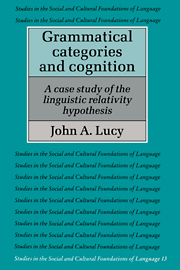Book contents
- Frontmatter
- Contents
- List of figures
- List of tables
- Acknowledgments
- Introduction
- 1 Background of the comparative research in Yucatan, Mexico
- 2 Comparison of grammatical categories: nominal number in English and Yucatec
- 3 Cognitive assessment
- 4 Conclusions
- Appendices
- A Construction of picture stimuli
- B Administration of task series
- C Scoring conventions and summary data for verbal tasks
- Notes
- References
- Index
A - Construction of picture stimuli
Published online by Cambridge University Press: 19 January 2010
- Frontmatter
- Contents
- List of figures
- List of tables
- Acknowledgments
- Introduction
- 1 Background of the comparative research in Yucatan, Mexico
- 2 Comparison of grammatical categories: nominal number in English and Yucatec
- 3 Cognitive assessment
- 4 Conclusions
- Appendices
- A Construction of picture stimuli
- B Administration of task series
- C Scoring conventions and summary data for verbal tasks
- Notes
- References
- Index
Summary
Basis of the decision to use line drawings
Stimuli used in the picture task series consisted of line drawings of typical Mayan village scenes and included specific numbers and types of objects relevant to the hypothesis in question. Constructed stimuli were used rather than actual village settings because it is very difficult to control the occurrence of objects (especially animate ones) in natural settings and because it is difficult to replicate the same setting across subjects and cultures. Artificial arrangements of objects were not used because it was difficult to include complex contextual features (for example, forest, house interiors), because it was difficult to include effectively many types of objects (for example, smoke, clouds), because pretesting revealed that small replicas of objects evoked unusual responses among the Yucatec subjects (for example, replicas of animals elicited great amusement), and because the practical difficulty of rapidly manipulating arrangements of objects made them difficult to use in some of the nonverbal tasks (for example, recognition memory).
Photographs of artificial arrays of objects would have solved this last problem, but not the others. Photographs of natural settings were rejected in part because they presented some of the same difficulties as the natural settings, especially the difficulty of setting up the situations to photograph so as to include the appropriate objects of interest and to exclude unwanted elements. More importantly, however, in pretesting photographs inevitably evoked too great an interest on the part of the Maya as to the particulars of who was involved, what they were doing, where the photograph was taken, etc. It can be argued that this was a desirable aspect of photographs, better reflecting speakers' actual responses to situations.
- Type
- Chapter
- Information
- Grammatical Categories and CognitionA Case Study of the Linguistic Relativity Hypothesis, pp. 162 - 178Publisher: Cambridge University PressPrint publication year: 1992



